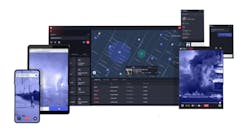With the wide availability today of vast arrays of security endpoint devices, including surveillance cameras, access control readers, intrusion sensors, and Internet of Things (IoT) devices, it can easily become overwhelming for central stations and security operations centers (SOCs) personnel to make sense of these various data inputs while simultaneously communicating with people in the field. While there are a variety of software platforms that help streamline the management of these various systems individually or attempt to aggregate them into a single pane of glass, real-time collaboration can still be a significant challenge.
Enter Carbyne, a provider of emergency contact solutions for public safety agencies, which on Wednesday announced that it is expanding the availability of its software-as-a-service offering to a variety of new vertical markets, including security.
According to Amir Elichai, the company’s Founder and CEO, Carbyne was created with the goal of helping to improve communications between “mission-critical” facilities, such as 911 and emergency contact centers, and first responders.
“When we started to work with this industry… we realized that the contact centers are not built to address the core challenges and it is split between different stakeholders in the chain – starting from citizens who used to call 911 without the ability to deliver any data, like video capabilities, imagery, real-time chat, text-to-911, location services, medical information, etc. Obviously, pre-Carbyne, they used to call 911 and just verbally communicate what is going on,” Elichai explains. “Then when you come into the infrastructure level, everything is on-prem, everything is wire-based with minimal ability to communicate information and then in the contact center itself, with the calls that are coming in, they are completely blind, so we are making all of the information accessible to them and not just the call takers but first responders in real time. So, taking video from citizens, sharing with responders that are now dispatching to the event – they are all now collaborating in real time.”
Pandemic Spurs New Applications
At the beginning of the Covid-19 pandemic, Elichai says they began to receive calls from insurance firms, private security companies and monitoring centers that wanted to leverage the Carbyne platform for their own needs, which gave them the impetus to expand the availability of the solution.
“If you think about it, we define them as a category which we call ‘mission-critical contact centers,’ which is a definition for several things. If I get in a car accident and I want to communicate with my insurance company, it’s very similar to a call to 911; I need to deliver as much information as possible to make the claim process as fast as possible and then aggregating the information to share it with adjusters, third-party companies, other insurance companies, etc.,” he adds. “If I’m a monitoring center and I’m working with an alarm company and a system is triggered somewhere, the alarm signals are sent to a contact center solution that, up until today, had no ability whatsoever to see all the data coming from the alarm system. Basically, they’ve had multiple screens with standalone solutions. Now when an alarm is going off and someone has broken into my house, this video will come into the Carbyne contact center platform and, in real time, be shared with private security teams that are now arriving at the house to check what is going on.”
Reducing False Alarms and Costs
“No current monitoring center is using contact center software to to integrate all of their IoT signals. Usually they are using a contact center provider, whatever it may be, and they have a standalone, homemade platform they build that is supposed to receive those signals and data,” Elichai explains. “What Carbyne did was, instead of paying for two platforms – your contact center provider and your homegrown [solution] – we can bring it to you all-in-one. Also, because we’re serving state and local governments, the ability for us to push information from our platform to 911 or emergency services is much easier. If you are a private security company or alarm monitoring center and someone breaks into one of your client’s house and you need to send police, we can automate this workflow and make it so easy for them to consume and use unlike what is happening today where a call comes into a contact center, they need to look at a different system and then pick up the phone and dial 10-digit numbers for the relevant 911 center.”
According to Elichai, the company is currently building its go-to-market strategy for the enterprise vertical and says they have already been in touch with several large organizations about deploying their software.
“In private security companies there are a lot of false alarms as you can imagine… and many of these companies that have started to work with us have seen a 20-25% reduction in false alarms and increased efficiency of like a 15% reduction in the amount of time they are sending people to check out what is going on which has translated to a big amount of [cost] savings for those companies,” Elichai says.
Joel Griffin is the Editor-in-Chief of SecurityInfoWatch.com and a veteran security journalist. You can reach him at [email protected].About the Author
Joel Griffin
Editor-in-Chief, SecurityInfoWatch.com
Joel Griffin is the Editor-in-Chief of SecurityInfoWatch.com, a business-to-business news website published by Endeavor Business Media that covers all aspects of the physical security industry. Joel has covered the security industry since May 2008 when he first joined the site as assistant editor. Prior to SecurityInfoWatch, Joel worked as a staff reporter for two years at the Newton Citizen, a daily newspaper located in the suburban Atlanta city of Covington, Ga.


